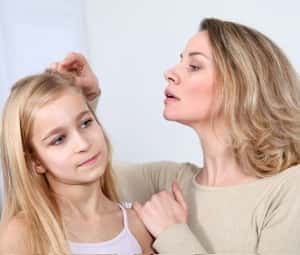
Lice are a source of tremendous frustration for families around the country (and even around the world). These parasitic insects that live by sucking human blood were not a big problem in most parts of the US in the middle of the 20th century, but by the time the century came to a close, they were everywhere. Worse, they had become resistant to many of the chemicals used to treat them. That left many parents with the urgent question: How do you kill lice most effectively?
Using Skin Cleanser to Kill Lice?
Q. We are a family of ten: my husband, myself, five girls with shoulder-length or longer hair and three boys. Last summer, one of our girls caught lice at camp. I started treating all the kids right away with over-the-counter treatments.
Nothing seemed to work, although I followed instructions to launder everything, comb with metal nit combs, etc. After a couple of months, I was frustrated and took them to the doctor. He prescribed a stronger lice treatment, so we tried that several times.
Again, to no avail. The lice were resistant. The girls’ heads were irritated from all the treatments.
Home remedies weren’t any better. Yesterday I learned that resistant lice are now common in many places. No wonder the shampoos didn’t work. It has been almost a year of struggle.
We tried Cetaphil Gentle Skin Cleanser last night. It took me five hours to coat and dry all ten of our heads. I have washed five heads of hair so far today, and I did not see a single living louse. This is thrilling, as it has not happened before. I am hopeful this will finally work.
Is There Any Science Behind This Way to Kill Lice?
A. The Cetaphil treatment for lice was described as 95 percent effective (Pearlman, Pediatrics, Sep. 2004). This was based on two smallish trials, with a total of 133 volunteers. We’d certainly prefer to have more and better research, but this is more science than many home remedies garner.
To use this approach, apply the cetyl alcohol-based cleanser to damp hair and then blow the hair dry. Leave the gentle skin cleanser on overnight and shampoo it off in the morning. This suffocates the lice. It doesn’t kill the nits, though, so the treatment must be repeated twice, at one-week intervals.
Suffocating Lice:
Recent studies support suffocation as a way to kill lice. One recent study of a mineral-oil based shampoo found it was safe and 96 percent effective (Wolf et al, PLOS One, June 10, 2016). The authors concluded that this is a good alternative to insecticide treatments, and the physical mode of action means the lice are less likely to develop resistance. Unfortunately, the shampoo they tested is available only in Europe.
A recent study compared a silicone-free treatment (Licener® shampoo) to one containing dimethicone (Jacutin® Pedicul Fluid). Both products work by blocking spiracles so the lice can’t breathe, and both were effective (Semmler et al, Parasitology Research, July 2017). These are also European products, but they might be available online.

